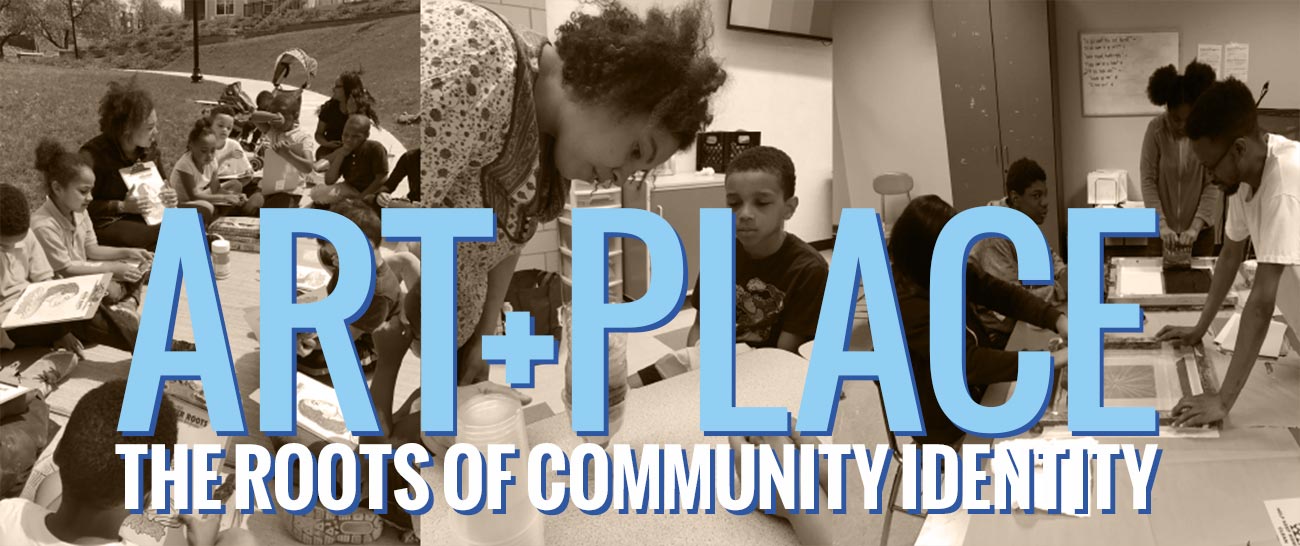ART+PLACE: The Roots of Community Identity
Art can knit together the lived experience of neighborhood identity with long term and sometimes abstract principles of community development. The Pittsburgh community of Larimer has been cultivating a local culture of sustainability through ecodistrict planning and has used art and creative placemaking to build capacity around neighborhood stormwater issues, urban agriculture and economic development. Alongside major investments in new housing, parks and infrastructure, grassroots community action is benefitting residents’ pursuit of economic stability and social equity. The community is demonstrating a distinctive type of resiliency, which is essential to its cultural identity.

artist made project logo
evolveEA is excited to be part of River Roots, an art project led by the Larimer community, and in collaboration with artist Alisha B. Wormsley, a team of stormwater experts, the Kingsley Association, and the Urban Redevelopment Authority. The collaboration is supported by a grant from ArtPlace America and grew out of a previous community engagement, Living Waters of Larimer (LWOL), in which evolveEA collaborated with the Kingsley Association, members of the Larimer Green Team, artists and stormwater experts. To support the River Roots project, evolveEA urban designer Ashley Cox attended the Artplace 2017 Annual Summit in Seattle, Washington. “Social justice as a collaborative art form was an exciting theme at this conference and connects to our River Roots project,” Ashley reflected.
Equity is a Process
“Social justice issues can challenge and enrich how we make community places. To inspire change in our communities we need multiple stakeholder groups, who sometimes have loosely overlapping objectives. Art provides the benefit of looking at a single problem through multiple lenses, allowing for greater understanding, input and shared power. That conversation needs to be elevated beyond a ‘report-out’ meeting into a dynamic conversation that affirms and improves the knowledge of all parties. These are the ways we can achieve equity through the creative process,” said Ashley.
She also emphasized the importance of acknowledging and quantifying the value of stakeholder participation, “which is important when we think about who can afford to sit at the table at community meetings.” Planning and design processes should reflect that value, and we need to consider ways to compensate members of the community who dedicate their time and energy in the interest of guiding a project to achieve the best possible outcomes. For Living Waters of Larimer, this principle was built into our project budget. We were able to create a paid youth apprenticeship position that brought immediate benefit to community members who participated in the project, while also raising the level of knowledge about stormwater issues among residents.
ideas and partnerships had to grow organically and thoughtfully
Supported by the Heinz Endowments, LWOL was intended to use art to build community and increase local capacity for stewarding creative rainwater infrastructure projects that would also provide amenities for the community. The LWOL effort collaboration included artists Betsy Damon and Bob Bingham and featured outreach events, advocacy for green infrastructure in Larimer’s new developments, the creation of an urban agriculture community strategy, and a vision for networked green infrastructure in the Negley Run Watershed.
Living Waters of Larimer helped secure funding for the Little Negley Run project, which reconstructs a portion of the natural stream that used to form part of Larimer’s boundary. LWOL also led to the ArtPlace grant that is funding the design and construction of the River Roots rainwater play park, where creative placemaking will help to teach people about how rainwater functions in their watershed.

Alisha Wormsley draws inspiration from Larimer’s children and their associations with water
River Roots
River Roots is the next phase of artist collaboration around stormwater. Alisha Wormsley has been working with our team and the Larimer community in designing the River Roots pieces that will be integrated within the new Larimer Park that will begin construction in 2018. Alisha involves the community in creating art in public places, beginning with the youngest and oldest residents from the neighborhood. “These are the people who are most present in the neighborhood on most days, so programs and places should be shaped around the needs and desires of senior citizens and children,” says Alisha. She further notes, “elders in the community know the community’s past and children can show you where it’s going in the future.” For River Roots this has meant facilitating a series of workshop activities for Larimer’s children and seniors that teach the project’s function as part of the watershed while collecting stories from the community to discover what associations they had with water.
Wormsley used her Community Listening approach to bring themes from these stories into the design, which translate to whimsical elements like imaginative creatures, the use of sound and reflected light, and elements that will be activated with rainwater. She says this project has been especially interesting because working with our team of designers and water experts has helped integrate the art in meaningful ways with the physical landscape as well as the social landscape of the community. Water is integral to Larimer’s neighborhood identity, and this project has created an opportunity build this identity into the landscape.
the design process for River Roots is documented in this presentation
River Roots is meant to be the first in a series of stormwater art projects in the Negley Run watershed and the team is creating a guide for others to emulate the process. This guide will also be available to other Artplace teams across the country, sharing back some of the important knowledge that the team gained from the 2017 Artplace conference. Ashley noted that one of the most exciting aspects of the project has been exploring art as a process and a means for community activation: “It’s been a long process because ideas and partnerships had to grow organically and thoughtfully,” she said.
The River Roots team includes Ian Lipsky, John Stephen, Malik Bankston, Robert Germany, Ivette Mongalo-Winston, Emily Mitchell, and evolveEA’s Christine Mondor, Ashley Cox and Nico Azel.


